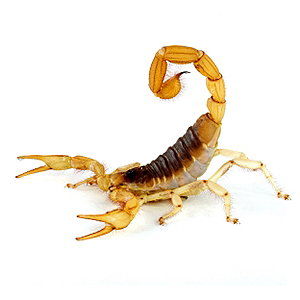

The “Arizona Bark Scorpion” is one of the most dangerous scorpions in North America!
Arizona Bark Scorpion or Centruroides Sculptuatuas is one of the most known species in the United States simply because of the danger that is represents for humans. It is part of the Buthidae family and part of genus Centruroides, as well as 69 other species of scorpions.
Bark Scorpion Anatomy
The Arizona Bark Scorpion ranges between 2.7 and 3.1 inches long and the males are often times larger than their female counterparts. They are yellow and have horizontal lines on the mesosoma. The tail is quite thin with a small telson as well as a stinger that has a very pronounced curvature.
These scorpions are stealthy predators that have very efficient and fast movements, and even though they look to be less harmful than the large and black scorpions, they actually have higher toxicity levels in their venom.
These scorpions will have hairs all over them in order to be able to recognize the terrain and to even find their threats and prey. They have eight legs and a firm but thin pedipalps that they hold their victims with.
Bark Scorpion Distribution & Habitat
Just like the name suggests, these particular scorpions are common within Arizona, but they are also located in Utah, New Mexico, Nevada as well as Chihuahua and Sonora, Mexico.
Due to their size and their moving ability, they are able to easily hide within their environment and conceal themselves from their threats. There are quite adapted to hot climates, because their body is resistant to loss of water.
While in the wild, they will lay in crevices, under rocks and in trees, but you may also find them indoors especially in dark cabinets, drawers, tubs, and sinks.
Food & Behavior
Because these scorpions are nocturnal animals, they will ambush their victims. They will often feed on medium to small animals such as cockroaches, crickets, spiders, beetles and other types of insects and have also been known to be cannibalistic.
Due to inhabiting warm climates, during the winter, they will hibernate in groups of 20 to 30 scorpions.
Bark Scorpion Reproduction
Unlike spiders who lay eggs and wrap them in sacks made of silk, the scorpion is born alive without needing to be externally incubated. The mother scorpion will have around 25 to 35 scorplings during the summer months, which will stay next to her and mainly on her back for around 3 weeks. After this time period, they will have their first mold and begin their independent lives. Whenever a female scorpion gives birth, they have to remain immobile and they will not show hostile behavior towards their offspring who are defenseless.
The life expectancy of this scorpion is around 6 years.
Bark Scorpion Venom
The venom of the bark scorpion is quite dangerous for a human. Besides just causing pain in the area, there is also vomiting, tingling, and illness that can last for several days.
Although, cases of death are very few, authorities will often issue alerts to protect your children, older adults, and pets who are vulnerable to the stings simply because the elder and children will not have a strong enough immune system reject the poison.
Effective antivenoms are available to treat the stings of the Arizona Bark Scorpion, but it is very important to stay alert and to avoid instances that involve them.
Threats
The main predator of the scorpion are grasshoppers, owls, mice, bats, shrews, tarantulas, lizards and centipedes.
Simply because of the fear that they cause, humans will have no intention of allowing the scorpion to live when they come across them, which is considered a threat to humans. These encounters between scorpions and humans are caused by the small spaces for these arachnids.
Thank you for reading about the “Arizona Bark Scorpion”! Stay tuned for more from the expert Scorpion Removal Experts at A BEE & PEST PRO.

Types of Scorpions - Scorpion Identification Chart, Key, Guide, Diagram
Types of Scorpions In Arizona - A Bee & Pest Pro